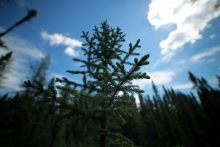You are here
New Study: NE Canadian Forests a Refuge as Warming Creeps North

A new study co-authored by HF Senior Ecologist Neil Pederson forecasts potential winners and losers in the changing climate of the northern boreal forest. The study of more than 26,000 trees in the Canadian province of Quebec covered an area the size of Spain.
According to the study, published today in the journal Science, boreal forests in far-northern latitudes may one day act as a climate refuge for black spruce, the foundational tree for the northwoods ecosystem – a major source of the world’s paper; home to caribou, snowshoe hare, lynx, and sable; and nesting site for dozens of migratory bird species.
“During this century, the northwoods will experience some of the Earth’s largest increases in temperature,” says Loïc D'Orangeville, postdoctoral researcher at Université du Québec à Montréal and Indiana University, who led the collaboration of scientists from six institutions (including Harvard Forest) in the U.S. and Canada. “It’s possible that only a relatively small part of North America’s boreal forest will have enough water to compensate for the increased demand.”
Northern boreal forests are a crucial part of the global climate puzzle, comprising nearly 30 percent of the Earth’s forested area and storing at least 20 percent of its carbon. The study’s tree ring analysis revealed these forests’ sensitivity to changes in temperature and precipitation.
North of a certain latitude (broadly 49 degrees North), the study showed, warming melts snow earlier and lengthens the growing season: good news for tree growth. As climate warms through 2070, more than two-thirds of the forested territory just above the 49thparallel should still be showing a positive response.
South of the 49th parallel, however, warming and the lengthened growing season are more likely to cause drought stress that could overwhelm black spruce. The researchers say this may explain increased tree mortality already being observed in the region.
“This part of the forest could adapt to climate change in our lifetime, if future warming stays below the temperature threshold,” says Neil Pederson, co-author of the study and a senior ecologist at Harvard Forest. “But the future cannot be perfectly predicted.” And, he cautions, unpredictable factors, such as the recent mega-fires in boreal regions of western Canada and Alaska, could disrupt this dynamic.
- Read the scientific paper in Science.
- Browse news stories via the Canadian Press, CBC News, Gizmodo, Business Insider, and Motherboard.
- Read the full press release.
(Photo of a black spruce by Loïc D'Orangeville.)

